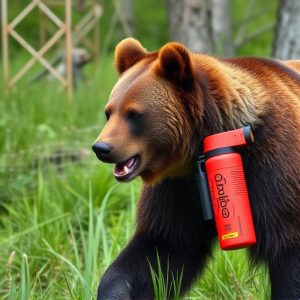Bear Spray: Water Safety Considerations for Hike Security
Bear spray, effective against bears, relies on capsaicin to deter or disable them, but its potency d…….
Bear spray, effective against bears, relies on capsaicin to deter or disable them, but its potency decreases in wet conditions due to runoff. To ensure Bear Spray Runoff Water Safety, users should avoid spraying near bodies of water, allow adequate drying time before entering waterways, and employ precise application techniques. Responsible usage involves proper storage, handling, and awareness of spray range and wind conditions. In case of accidental contact with eyes or skin, flush with clean water for 15 minutes. Keep the spray secure from children and pets to prevent accidents.
“Enhancing your hiking experience and ensuring water safety during outdoor adventures, bear repellent spray is a crucial tool for any nature enthusiast. This article explores the effectiveness of bear spray in deterring these majestic yet potentially dangerous creatures. We delve into the science behind its operation, addressing key safety precautions. Additionally, we uncover critical interactions with water, providing insights for responsible usage. Get ready to discover best practices for safe hiking, ensuring you and your surroundings remain protected from unexpected encounters.”
- Understanding Bear Spray: Effectiveness and Safety Precautions
- Bear Spray and Water Interaction: What You Need to Know
- Best Practices for Safe Usage During Hiking Adventures
Understanding Bear Spray: Effectiveness and Safety Precautions
Bear spray, also known as bear repellent, is a crucial tool for hikers navigating areas inhabited by bears. Its effectiveness lies in its ability to create an unpleasant sensation for bears, often causing them to retreat or avoid the area. However, understanding how it works and its limitations is essential for safe hiking practices.
When used correctly, bear spray can provide a powerful deterrent. It typically contains capsaicin, the same ingredient that gives chili peppers their heat. This compound irritates a bear’s eyes, nose, and respiratory system, temporarily disabling them and allowing you to create distance or escape. Safety precautions are vital; users should practice spraying techniques before hiking and keep the can accessible during the hike. Bear spray is most effective when used as a last resort, and its effectiveness can be reduced if it comes into contact with runoff water or wet surfaces, so hikers must be mindful of weather conditions and nearby bodies of water.
Bear Spray and Water Interaction: What You Need to Know
When it comes to bear spray and its effectiveness, understanding the interaction with water is crucial for your safety while hiking in bear country. Bear spray is a popular and necessary tool for deterring bears during outdoor adventures, but knowing how it behaves when exposed to water can make all the difference. Water can significantly impact the performance of bear spray, leading to reduced efficacy if not managed properly.
The primary issue arises from the runoff created when applying bear spray near bodies of water or wet areas. The mist from the spray can carry active ingredients, including capsaicin and other irritants, into the water body. This not only reduces its potency on surfaces but can also have adverse effects on aquatic life and ecosystems. Proper usage techniques are essential to minimize this impact. Users should aim for the intended target and avoid spraying in directions where water bodies or streams are located. Additionally, allowing sufficient time for the spray to dry before entering waterways is vital to prevent any potential harm.
Best Practices for Safe Usage During Hiking Adventures
When using bear repellent spray during hiking adventures, prioritizing safety is paramount. Always ensure proper training and understanding of the product before setting out on your trail. Familiarize yourself with the spray’s range, wind conditions, and application technique. Bear spray is most effective when used defensively, so maintain a safe distance from bears and only deploy when necessary. Proper storage and handling are also crucial; keep the can in a secure, dry place to prevent runoff water contamination and accidental discharge.
Water safety plays a significant role in bear repellent spray usage. Avoid using near bodies of water or slippery surfaces as runoff could harm wildlife or yourself. In case of contact with eyes or skin, immediately flush with clean water for at least 15 minutes. Keep the spray can out of reach of children and pets to prevent accidental use. Remember, responsible usage and knowledge of bear behavior are key to ensuring a safe hiking experience in bear country.
When embarking on hiking adventures in areas known for bear populations, prioritizing water safety and understanding the interaction between bear spray and runoff is paramount. Bear spray remains an effective deterrent, but proper usage and awareness of its limitations are key to ensuring your safety. By following best practices and staying informed about the product’s dynamics with water, hikers can minimize risks and enjoy a more secure outdoor experience. Incorporating these measures into your hiking routine makes bear spray a valuable tool for navigating the wilderness responsibly.


